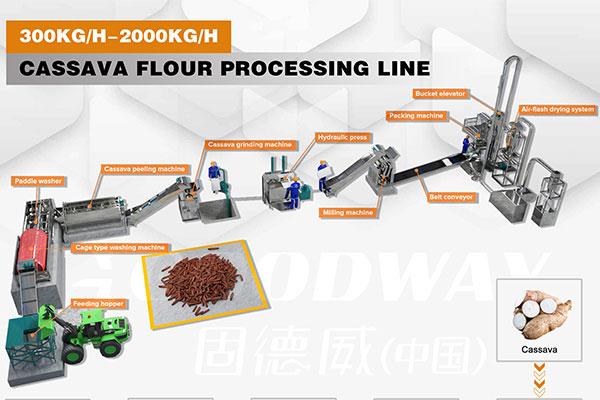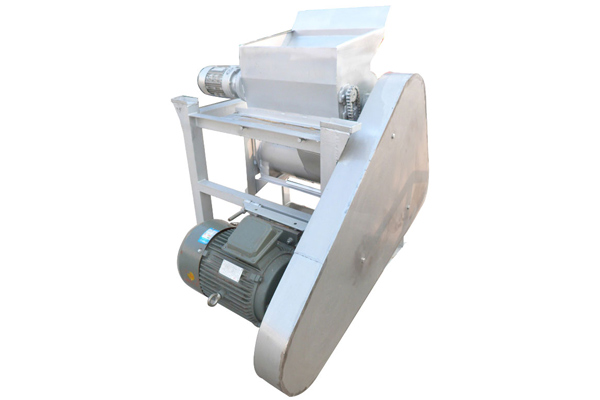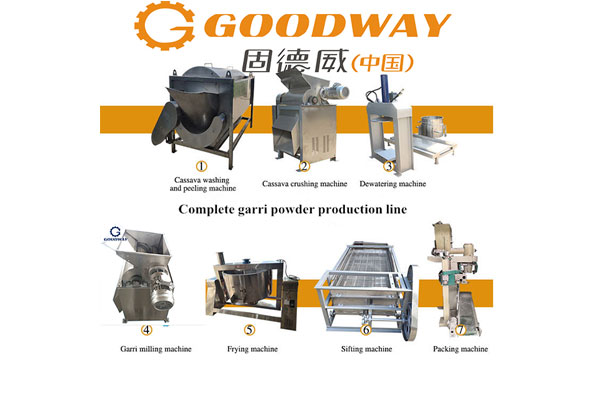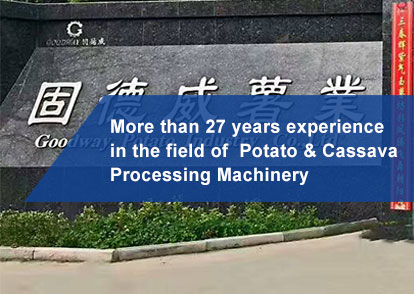The production process of cassava starch
Cassava Selection→Weighing and conveying→Cleaning and conveying→Rotary cage cleaning→Cleaning and conveying→Coarse crushing→Coarse comminution→Pressure Curved Screen→Fine comminution→Second to Fifth Curve Screening→Sand remover→Curve Screening Fine→Rotary filter→Twice Disk Separation→Mention white→Rotary filter→Cyclone Washing Refining→Dehydration→Airflow dryer→Finished product packaging.
Operating methods (part of the process, brief introduction of operation)
1. Selected raw materials:
The quality of starch has a great relationship with the selection and purchase of raw materials. Less than 10 months of cassava flour yield is low, more than 24 months of old cassava has been qualitative, causing greater difficulties in crushing and crushing, making the rate of decline and cost increase, all affecting economic benefits, requiring that the first step must be to put good raw materials into storage.
2. Cleaning and conveying
The purpose of cleaning is to remove sand, soil, peel, reduce starch ash, and facilitate the next process. Cleaning is carried out while conveying, so the feeding should be uniform. With too much feeding and no space in the rotating cage, cassava can not roll and can not reach the purpose of peeling and cleaning. Too little material can not reach the production capacity. Operators should also pay attention to the pressure of water, too low water pressure with no sediment, the general water pressure can not be less than 0.25 Mpa, always pay attention to the operation of the cage and conveyor, can not form a backlog of raw materials in this process. The machine usually works seven days with lube oil.
3. Crush
Considering cassava roots are very long, they are lignified near the main stem, so they cannot be crushed unless they are crushed. On the one hand, the purpose of crushing is to ensure the normal operation of the crusher. Some factories do not have crushing technology to increase the crusher load and reduce the service life. On the other hand, it is to improve the yield and quality of starch and the yield of starch.
When operating, pay attention to observe the temperature of the motor and the sound of the machine, the sound suddenly becomes smaller, indicating that there is too much material in the crusher, at this time the amount of feed should be reduced. It is necessary to add proper amount of backhaul water, less material can not be taken away after crushing, more waste. In addition, to master the tightness of the triangle belt, too loose triangle belt, reduce the efficiency of crusher, too tight to increase the load of motor, damage the motor shaft, so the operator should concentrate, can not leave the post, strict operating procedures. The quality of crushing directly affects the output of this class and the next process. The diameter of fragments is generally 1 cm.
4. Crush
After crushing, the mixture of cassava pulp (about 1 cm in diameter) is put into the crusher. The crushing process is divided into one crushing and two crushing. Why two crushing? On the one hand, cassava is too long and lignified substances are too much. For example, once crushing, starch yield can not meet the requirements. On the other hand, the quality of cassava starch is destroyed by centralized crushing, which can crush large granules of cassava starch into small granules, and can not make starch free sufficiently, thus increasing the difficulty of filtering starch. So now we are divided into two crushing stages. The pulp residue after the first crushing stage first enters the first pressure curling screen to filter out the high-quality starch. A large residue under the pressure curling screen is added with a certain amount of backhaul water to make it enter the second crushing stage. The fine residue after the second crushing stage enters the second pressure curling screen. This crushing process is the most advanced, and not only does not destroy the quality of starch. The yield of starch was increased by 3-5% by adding backhaul water when crushing.
In the economic accounting of starch factory, water consumption and starch yield are two important indicators. Therefore, in the process of using backhaul water and adding clean water, proper amount of backhaul water must be mastered. There is a certain amount of backhaul water returned from curly sieve, which should be fully connected with the previous process. The use of water can take away the crushed materials without causing waste. The mill runs for an hour and then contacts the upper cover of the mill bearing with the hand to see if the temperature rises, and then observes whether the temperature of the motor rises, and strictly controls the feed rate. Because there are too many lignified materials, it is difficult to crush. If the machine is not working properly, it should be shut down and cleaned. There is a square mouth above the crusher. First, the upper part is cleaned manually, and then the pocket is connected to the mouth. When the machine is started to clean, the lignified crushed materials are completely discharged. When cleaning materials, special person should take care of the start switch to prevent accidents.
In the process of operation, attention should be paid to the amount of material stored in the ground pool of the crusher, and the transfer pump should be started in time so that the material can be sent to the upper working procedure. From cleaning and conveying to crushing, the whole equipment is continuous operation. After crushing, the slurry and slag are sent to the later process by the transfer pump. Therefore, the operators in this section will play an important role in the normal and continuous operation of the whole equipment.
Cassava chips, weighed by belt conveyor pulp, are fed into the cleaning cage at the speed of 100 kg/min to remove dust. The chips are fed into hammer mill twice by screw conveyor to crush. In order to reduce the flying of dry powder and loss, the chips are fed into the pulp pool by induced draft fan through separator. The pulp is pumped into the impregnating pool by mixed-flow pump and immersed in hot water at 40 C for 5 hours. After that, the slurry is pumped into the slurry tank and the concentration is adjusted to enter the slurry and slag separation process.

 EN
EN
 fr
fr  es
es  it
it  pt
pt 







